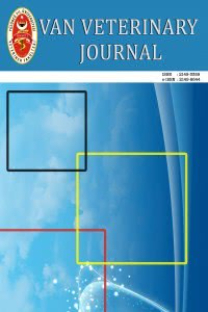Dose dependent effectiveness of topical selamectin on puppies with ascaridiosis
köpek yavrusu, askaridiozis, ilaç tedavisi, dışkı, iplik solucanı enfeksiyonları, köpek, klinik görünüm, avermektinler, biyokimyasal parametreler
Askaridiozisli yavru köpeklerde topikal selamektin uygulamasının doza bağlı etkinliği
puppies, ascaridiosis, drug therapy, faeces, nematode infections, dogs, clinical aspects, avermectins, biochemical parameters,
___
1. Ayaz, E., Deger, S., Gül, A., Yüksek, N. (2001): Van kedilerinde helmintlerin yayılısı ve halk saglıgı yönünden önemi. Türkiye Parazitoloji Dergisi, 25 (2): 166-169.2. Barbabosa, I.M., Tsuji, O.V., Cabello, R.R., Cardenas, E.M.G., Chasin, O.A. (2003): The prevalance of Toxocara cati in domestic cats in Mexico City. Veterinary Parasitology, , 114: 43-49.
3. Done, J.T., Richardson, M.D., Gibson, T.E. (1960): Experimental visceral larva migrans in the pig. Res. Vet. Sci., 1, 133-151.
4. Habluetzel, A., Traldi, G., Ruggieri, S., Attili, A.R., Scuppa, P., Marchetti, R., Menghini, G., Esposito, F. (2003): An estimation of Toxocara canis prevalence in dogs, environmental egg contamination and risk of human infection in the Marche region of Italy. Veterinary Parasitology, 113, 243-252.
5. Halliwell, R.E.W., Gorman, N.T. (1989): Veterinary Clinical Immunology. First Edition, W.B. Saunders Company, Philadelphia.
6. Helwigh, A.B., Lind, P., Nansen, J. (1999): Visceral larva migrans: migratory pattern of Toxocara canis in pigs. International Journal for Parasitology, 29, 559-565.
7. Hopkins, T.J., Gyr, P., Hedemann, P.M. (1988): Nematocidal and cestocidal efficacy of a tablet formulation containing febantel, pyrantel embonate and praziquantel in dogs. Vet. Med. Rev., 59, 71-75.
8. Jain, N.C. (1993): Essentials of Veterinary Hematology. Lea & Febiger, Philadelphia., 19-20.
9. McTier, T.L., Siedek, E.M., Clemence, R.B., Wren, J.A., Bowman, D.D., Hellmann,K., Holbert, M.S., Murphy, M.G., Young, D.R., Cruthers, L.R., Smith, D.G., Shanks, D.J., Rowan, T.G., Jernigan, A.D. (2000): Efficacy of selamectin against experimentally induced and naturally acquired ascarid (Toxocara canis and Toxascaris leonina) infections in dogs. Veterinary Parasitology, 91 (3-4), 333-345.
10. Norusis, J.M. (1986): SPSS/PC. SPSS inc. Chicago,
11. Novotny, M.J., Krautmann, M.J., Ehrhart, J.C., Godin, C.S., Evans, E.I., McCall, J.W., Sun, F., Rowan, T.G. (2000): Safety of selamectin in dogs. Veterinary Parasitology, 91 (3-4), 377-391.
12. Payne, P.A., Ridley, R.K. (1999): Strategic use of ivermectin during pregnancy to control Toxocara canis in greyhound puppies. Veterinary Parasitology, 85, 305-312.
13. Robertson, I.D., Thompson, R.C. (2002): Enteric parasitic zoonoses of domesticated dogs and cats. Microbes and Infection, 4, 867-873.
14. Six, R.H., Sture, G.H., Thomas, C.A Clemence, R.G., Benchaoui,H.A., Boy, M.G., Watson, P., Smith, D.G., Jernigen, A.D., Rowan, T.G. (2000): Efficacy and safety of selamectin against gastrointestinal nematodes in cats presented as veterinary patients. Veterinary Parasitology, 91 (3-4): 321-331.
15. Sommerfelt, I.E., Santillan, G., Lopez, C., Ribicich, M., Franco, A.J. (2001): Immunological and hematological response in experimental Toxocara canisinfected pigs. Veterinary Parasitology, 96, 127-134.
16. Turgut, K., Ok, M. (2001): Kedi ve Köpek Gastroenterolojisi. Bahçıvanlar Basım Sanayi A.S., Konya.; 296-300.
17. Urquart, G.M., Armour, J., Duncan, J.L., Dunn, A.M., Jennings, F.W. (1996): Veterinary Parasitology. 2 nd ed., Blackwell Scientific Publications, Oxford. 53-73
- ISSN: 1017-8422
- Yayın Aralığı: 3
- Başlangıç: 1990
- Yayıncı: Yüzüncü Yıl Üniv. Veteriner Fak.
Dose dependent effectiveness of topical selamectin on puppies with ascaridiosis
Nazmi YÜKSEK, NURİ ALTUĞ, ABDULLAH KAYA, Tevfik Zahid AĞAOĞLU, Yaşar GÖZ, CUMALİ ÖZKAN
Serum zinc, copper and thyroid hormone concentrations in heifers with retarded growth
İHSAN KELEŞ, Nurcan DÖNMEZ, NURİ ALTUĞ, EBUBEKİR CEYLAN
Hindi lenfoid organlarında (Timus, ve Bursa Fabricius) yaşa bağlı olarak mast hücrelarinin dağılımı
Turan KARACA, MECİT YÖRÜK, SEMA USLU
Nutrient and botanical composition of pasture in Ceylanpınar Agriculture Farm
